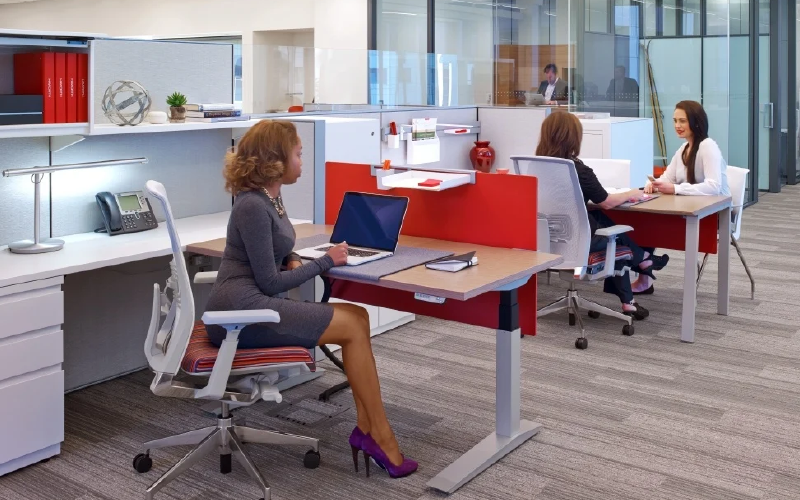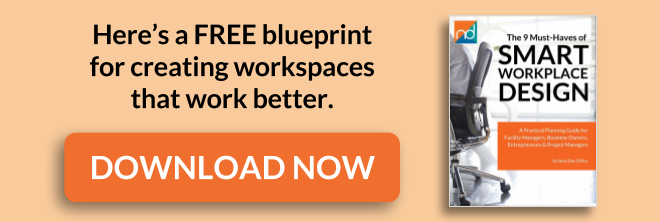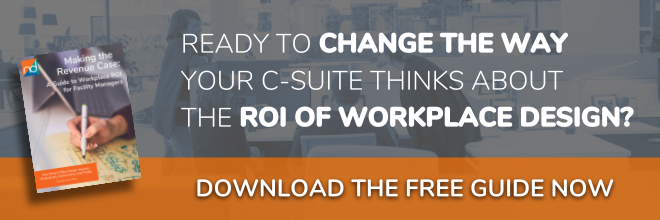7 Tips for Measuring Your Workplace ROI
By Matt Brady

There are some CEOs who fully embrace the changing nature of the modern office and encourage bold design choices and new ways of working.
Others may accept the idea that the traditional workplace has evolved, but they remain skeptical. They understand concepts like flexible space and creative common areas. They might even get the whole idea of “resimercial design,” even if they don’t much care for the word.
But they aren’t sure how much those things benefit the bottom line.
“Prove it,” they say.
So just like that, you get another major project on your to-do list.
“Show me our Workplace ROI.”
It’s definitely a daunting demand, and with an already full agenda, most facilities managers simply don’t have the capacity to add “investigative reporter/data analyst/human logistics expert” to their job title.
Some might not even have an idea how or where to begin.
WHAT IS WORKPLACE ROI?
In simple terms, workplace ROI (return on investment) is a measure of how your physical office space impacts a company’s profitability.
You may have noticed that workplace ROI has become a more common topic of corporate conversation.
Not long ago, workplace design was just another static budget item.
It was lumped in there with real estate costs, office furniture expenses and line items like computers, phone systems, copiers and coffee filters.
The measure of success for facilities managers was how much they came in under budget. As long as the employees weren’t sitting on milk crates if you could set up an office and save money, you’d be hailed as a hero.
That’s an exaggeration of course, but depending on where you work, not much of one.
Today, some of the biggest companies in the world have realized that their offices are investments.
They’ve seen that putting money into the right design, with the right layout and the right furniture can transform an office from “just a place where people work” into a powerful business tool.
Whether or not you’ve been tasked with figuring out your office ROI, knowing how design decisions in the physical space affect productivity and profits can add an entirely new dimension to how you look at your workplace.

CALCULATING VALUE
The key to understanding the ROI of a workplace (and the ROI of workplace changes) starts with understanding the value of the people who work in that space.
Every employee is paid a salary. On top of that salary, the business pays additional costs in the form of benefits, insurance and taxes (the standard is around 30% of the salary).
You can stop at that number, but to truly demonstrate value and maximize impact, you should base ROI calculations on how much revenue that employee is expected to generate.
The ratio will vary by company, industry and individual, but the basic idea is that each person hired is brought on to do more than just cover their own salary. Some industries use 3 to 1, others can go as high as 20 to 1.
Here’s an example: Let’s say you are planning changes to the sales department, and the average salary of a salesperson is $60,000.
Add company costs to bring that to $78,000 per employee.
Assuming a ratio of 6 to 1, let’s say that each salesperson is expected to produce $468,000 per year.
Divide $468,000 by 250 (the average number of days worked in a year) to get the cost per day: $1,872.
Break that number down into hours (assuming 8 hours per day) and then minutes.
$3.90 is the value of one minute of a salesperson’s time
It may seem silly to break things down to the minute, but those costs add up quickly and don’t seem as insignificant when applied to whole departments and multiplied over weeks and months.
Think about this: After distributing a survey, you find that, on average, salespeople are distracted by noise an average of 20 minutes per day. You have a 10-person sales team all located in the same area. That’s a productivity loss of $195,000 per year!
If you could make design changes to reduce noise and distraction by just 25%, you could save $48,750 per year.
While this is a broad example, you can see that by adding dollar values, you give much more weight and urgency to your space change and furniture requests.
RELATED READ | OFFICE ACOUSTICS: 9 WAYS TO MANAGE SOUND

GETTING STARTED
The methods and tactics you use to determine your workplace ROI will ultimately depend on the priorities and goals of your business.
Every company is different, but the process is the same for anyone.
FIRST: Ask questions. Collect data. Calculate costs.
THEN: Make changes. Ask more questions. Collect more data. Recalculate costs.
It sounds simple, but each of those steps takes time and effort. Exactly how it’s done is up to you.
Maybe you only have the capacity to focus on one project at a time. That’s fine. Starting small is better than not starting at all.
Whether you dive into workplace ROI head first or just stick your toes in, here are seven tips to help get you going…
1. DEFINE YOUR COMPANY GOALS
Before you begin to measure, you need to establish what’s most important to the leadership and the company.
Understand your company’s vision, mission, values and goals BEFORE creating key performance indicators (KPIs) and collecting data.
Think of it as setting a start and finish point on the GPS.
Understanding where the company wants to go and what they believe in, will help you make sure that any changes you make will move the organization in the right direction.
2. KNOW HOW YOUR BUSINESS WORKS
In addition to the big picture, you’ll need a firm grasp of the day-to-day details of your company. Understanding the process and flow of work in your office is key.
- How does information (or product) move through the building?
- How do the departments interact?
- Where are the biggest efficiency opportunities?
If you’re not already, become an expert on what employees do all day. Not what their job title or job description says they do, but what they actually do.
Be aware that people may also tell you one thing, but do something else entirely. You may need to supplement or verify responses with observation.
3. COLLABORATE & SHARE
Facilities managers are piling on more and more hats these days, but ROI research requires input and insight from other departments.
Human Resources can help you calculate employee costs and values. Department heads can add insight to job duties and behavior. Your goal is to get a holistic picture of how your office really works (or really doesn’t).
If your mission is to improve the function and flow of the entire workplace, all of those other departments will have a clear incentive to cooperate.

4. CONNECT WITH THE C-SUITE
You want your ROI efforts to have maximum impact.
It won’t do much good if you help save the company on energy costs or injury claims if the most important metric of leadership is innovation.
Of course, CEOs appreciate any cost savings, but the secret to building momentum is aligning with their priorities.
Figure out what matters to the C-suite most and stick that metric squarely in your ROI bullseye.
You want to connect the dots from physical space to personal performance to profits. The clearer that line is, the easier it will be to get buy-in and trust from your leadership.
5. COMMUNICATE WITH END-USERS
Great workplace design isn’t created in a vacuum.
Yes, there are plenty of brilliant designers and architects who can create an office masterpiece worthy of a Forbes or Fast Company photo spread. But if you want to create something truly useful for the company, a smart design strategy starts with input from your people.
Talk with the men and women who use those spaces every day. Ask questions. Start conversations. Conduct surveys, hold company-wide “town halls,” and launch pilot programs. Become an amateur detective and part-time investigative journalist.
Your people are the key to your success.
Listening to them can also save you from making expensive mistakes.
Let’s say that you’ve figured out that standing desks can boost productivity. You’re ready to present your findings that a 10% increase in productivity justifies an investment in 10 standing desks.
But before you pull the trigger, you sit down with a few programmers who confess, “Stand-up desks are great, but what would REALLY save me time is two more monitors.”
You look into this and decide that the time and cost savings after adding more monitors are infinitely more compelling than the standing desk decision.
The more you understand how your workplace works today, the more you can make it work better tomorrow.

6. COLLECT & MEASURE
Data is your best friend and your secret weapon. It’s the stuff that ROI dreams are made of. And I’m not being hyperbolic here, you can’t justify anything without hard numbers.
How do you get that information? You’ve got plenty of options:
- You can implement the process yourself or hire outside companies to help
- You can distribute paper surveys, launch online questionnaires, or interview employees face-to-face
- You can work with consultants who use state-of-the-art sensors, trackers and logistics technology to create activity and adjacency studies
- You can analyze your whole company, focus on specific departments, or shine the spotlight on one guy in accounting
- You can gather data weekly or annually
It can all be a bit overwhelming.
But just getting started by focusing on a handful of important metrics can prove valuable.
If you don’t know where to begin, get a feel for issues with a general workplace survey or a fact-finding meeting. Work with other departments to uncover data outliers (a spike in absenteeism, declining performance issues, more missed deadlines in the summer, etc). Identify productivity traps and efficiency leaks and opportunities for improvement.
Gathering data can be one of the most difficult tasks, but it can also provide some of the most meaningful revelations.
7. ANALYZE, SOLVE & PRESENT
These last steps are the most critical.
All of that collected data doesn’t have any worth unless you do something with it.
Do you want to make the case that a well-designed workplace can add value to the company? Do you want to show that layout and furniture choices can solve productivity and personnel problems?
That’s going to take some creativity and effort.
After you collect the data and analyze the problems, you’ll need to create and implement solutions.
You can get attention by highlighting savings with dollar amounts but don’t miss the opportunity to provide deeper insights. By expanding your knowledge of how the office space works best, you can make recommendations about industry insights and workplace trends.
And when reporting ROI, it’s sometimes even more effective to shift your argument from “money saved” to “money earned.” Facility requests that show value over cost are more powerful than requests without data or insights to back them up.
Here’s an important point: those solutions are going to have to actually work. They’ll need to improve those productivity and efficiency issues, or else it’s back to the drawing board.
That’s why, when it comes to workplace ROI, it’s important to choose your battles. Determine where and how to be the most effective and accept that there are some issues that can’t be solved with collaborative space, gourmet coffee bars, or privacy booths.

BREAKING BARRIERS
Determining workplace ROI is a powerful way to gain new perspectives on your professional space. It will help provide insights that can guide major decisions about renovation, relocation, or expansion.
But it can also help shed light on little changes that have a big impact.
Once you start asking questions and collecting data, you’ll find all sorts of ways to remove obstacles to productivity.
You’ll plug leaks and smooth edges and silence distractions.
You’ll boost morale, increase engagement and build culture.
And maybe most importantly, you’ll knock down all of the barriers that keep good people from doing great work.


